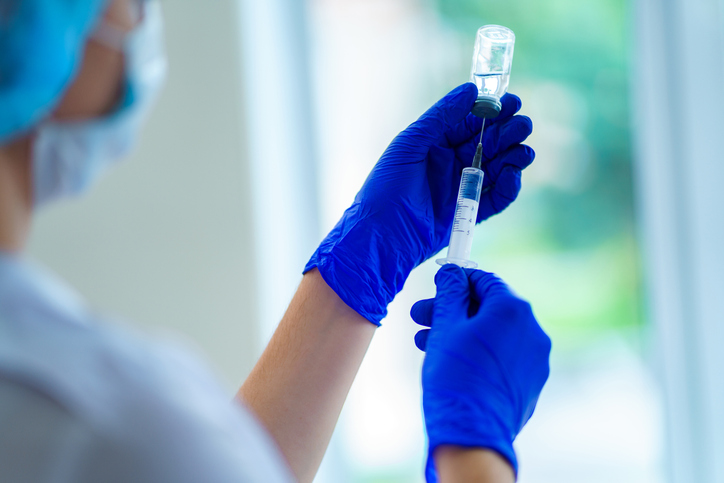Key points
- Rabies biologics include vaccine and immunoglobulins.
- Increase efficacy and safety when following ACIP guidelines for pre- and post-exposure prophylaxis for human rabies.
- Contact your health department with questions about rabies vaccine or HRIG.
- Don't interrupt rabies post-exposure prophylaxis because of mild reactions; serious reactions are rare and need careful management.

Available biologics in the U.S.
Rabies biologics for pre- and post-exposure prophylaxis include vaccine and immunoglobulins.
The tables below summarize the human rabies vaccines and immunoglobulins currently available in the United States.
Human rabies vaccine
Single-dose vials of rabies vaccine should be reconstituted with accompanying sterile diluent to a final volume of 1mL before administration. Administer rabies vaccine intramuscularly for adults in the deltoid area, or for children in the deltoid or the anterolateral aspect, or in the thigh. Do not administer vaccines in the buttocks or gluteal area.
Rabies vaccine supply status
Human rabies immune globulin
Post-exposure prophylaxis with human rabies immune globulins (HRIG) is indicated for ONLY people who did not receive ACIP-recommended 1) pre-exposure prophylaxis (PrEP) or 2) post-exposure prophylaxis (PEP) for rabies.
The recommended dose of HRIG is 20 IU/kg body weight for all age groups, including children. If the wound is small and on a distal extremity (e.g., finger, toe), use clinical judgment to decide how much HRIG to inject to avoid complications (e.g., ischemia) due to localized swelling of the finger or fingers. Deliver any remaining dose intramuscularly at a site distant from where the vaccine was given.
If wounds are extensive, do not exceed the dose-appropriate volume of HRIG. If the indicated volume is inadequate to inject all wounds, you can dilute the HRIG with normal saline to ensure sufficient volume to inject all wounds.
The one exception is the newer and more concentrated version of HRIG, HyperRAb 300 IU/ml, which requires using dextrose 5% in water (D5W) as the diluent. HRIG dilution is particularly important in children whose body weight might be small in relation to the size and number of wounds.
| Biologic | Product name/Manufacturer | Potency | Diluent |
|---|---|---|---|
| Human immunoglobulin | KEDRAB™/Kedrion Biopharma and Kamada Ltd | 150 IU/mL | Saline |
| Human immunoglobulin | HyperRab™S/D/Grifols | 150 IU/mL | Saline |
| Human immunoglobulin | HyperRab®1/Grifols | 300 IU/mL1 | dextrose 5% in water (D5W)1 |
1 Note HyperRab® immunoglobulin product has a different concentration compared to all other rabies immunoglobulins (including the very similarly named HyperRab™S/D), requiring lower volumes to administer the recommended dose of 20 IU/kg; take care to ensure the correct dose of immunoglobulin is administered to allow adequate immune response
Rabies immunoglobulin supply status
Common errors when administering rabies biologics
Learn more about how to increase the efficacy of and avoid errors related to rabies biologics.
Rabies vaccine administered in the gluteal area
All U.S.-licensed rabies vaccines must be administered intramuscularly, but the gluteal area is unreliable and carries a risk of sciatic nerve damage. If your patient has received rabies vaccine in the gluteal area, you must repeat the dose(s).
HRIG was administered, but not into the wound
HRIG provides neutralizing antibodies at the site of exposure until the body can produce vaccine-mediated antibodies[1]. The recommended dose for HRIG is 20 IU/kg, administered directly into the wound. However, if the wound is not sufficiently infiltrated, you may re-administer it directly into the wound if it doesn't exceed 40 IU/kg. A higher dose may negatively impact the patient's response to the vaccination.
HRIG is still required for PEP when there is not an identifiable exposure wound. HRIG should be administered at a site distant from where the vaccine is administered.
HRIG was not administered.
HRIG is a critical component of post-exposure prophylaxis. It protects previously unvaccinated people by providing passive immunity to the patient while they mount an immune response.
If HRIG was not administered on day 0 when vaccination was begun, it can be administered up to and including day 7 of the PEP series.
Vaccine and HRIG were administered in the same location.
HRIG can neutralize vaccines if they are given at the same site, so the biologics must be administered in separate anatomical locations.
If both are given in the same basic site, you will need to re-administer vaccine in a distant location. You may also need to readminister HRIG as long the total dose to the patient doesn't exceed more than 40 IU/kg.
The recommended PEP schedule was not followed.
While every attempt should be made to adhere to the recommended vaccination schedules, delays of a few days for individual doses are unimportant, but longer lapses of weeks or more may have unpredictable consequences for the patient.
If a deviation has occurred, maintain the recommended spacing for subsequent doses.
You can determine if the deviation requires consultation with a public health professional using this tool.
Managing adverse reactions to rabies biologics
Don't interrupt rabies PEP if there are mild reactions to the treatment; manage them with anti-inflammatory drugs like ibuprofen or acetaminophen.
Ideally, the same vaccine should be used throughout the series (either HDCV or PCEC). However, if severe allergic reactions occur, you may need to switch to an alternate vaccine to complete the series.
Have antihistamines and epinephrine ready to counteract anaphylactic reactions in patients with a history of strong allergic or inflammatory reactions to vaccines. Closely monitor patients after vaccination.
Serious reactions to rabies vaccines are rare and require careful consideration before discontinuing vaccination. Healthcare providers should seek advice from local or state health departments for managing serious reactions.
Report significant adverse events
Patient assistance programs for rabies biologics
Manufacturers' patient assistance programs that provide rabies medication to uninsured or underinsured patients may be available for qualified patients. For more information on these programs, including eligibility requirements, please contact the manufacturers directly.
Rabies vaccine
Sanofi Pasteur–Imovax®
Phone: 1-800-822-2463
www.sanofipasteur.us
Bavarian Nordic–Rabavert®
Phone: 1-844-422-8274
https://bnvaccines.com
Human rabies immune globulin
Grifols–HyperRab®
Phone: 1-833-504-9983
www.hypermunes.com/en/hcp
Kedrion–KEDRAB®
Phone: 1-866-234-3732
https://mykedrab.medmonk.com